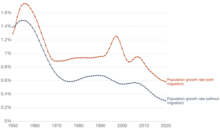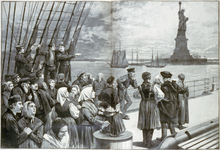
A | B | C | D | E | F | G | H | CH | I | J | K | L | M | N | O | P | Q | R | S | T | U | V | W | X | Y | Z | 0 | 1 | 2 | 3 | 4 | 5 | 6 | 7 | 8 | 9
| United States citizenship and immigration |
|---|
| Immigration |
| Citizenship |
| Agencies |
| Legislation |
| History |
| Relevant legislation |
|
|




Immigration to the United States has been a major source of population growth and cultural change throughout much of its history. In absolute numbers, the United States has by far the highest number of immigrants in the world, with 50,661,149 people as of 2019.[1][2] This represents 19.1% of the 244 million international migrants worldwide, and 14.4% of the United States' population. In 2018, there were almost 90 million immigrants and U.S.-born children of immigrants in the United States, accounting for 28% of the overall U.S. population.[3]
According to the 2016 Yearbook of Immigration Statistics, the United States admitted a total of 1.18 million legal immigrants (618k new arrivals, 565k status adjustments) in 2016.[4] Of these, 48% were the immediate relatives of United States citizens, 20% were family-sponsored, 13% were refugees or asylum seekers, 12% were employment-based preferences, 4.2% were part of the Diversity Immigrant Visa program, 1.4% were victims of a crime (U1) or their family members were (U2 to U5),[5] and 1.0% who were granted the Special Immigrant Visa (SIV) for Iraqis and Afghans employed by the United States Government.[4] The remaining 0.4% included small numbers from several other categories, including 0.2% who were granted suspension of deportation as an immediate relative of a citizen (Z13);[6] persons admitted under the Nicaraguan and Central American Relief Act; children born after the issuance of a parent's visa; and certain parolees from the former Soviet Union, Cambodia, Laos, and Vietnam who were denied refugee status.[4]
Between 1921 and 1965, policies such as the national origins formula limited immigration and naturalization opportunities for people from areas outside Northwestern Europe. Exclusion laws enacted as early as the 1880s generally prohibited or severely restricted immigration from Asia, and quota laws enacted in the 1920s curtailed Southern and Eastern European immigration. The civil rights movement led to the replacement[7] of these ethnic quotas with per-country limits for family-sponsored and employment-based preference visas.[8] Between 1970 and 2007, the number of first-generation immigrants living in the United States quadrupled from 9.6 million to 38.1 million residents.[9][10] Census estimates show 45.3 million foreign born residents in the United States as of March 2018 and 45.4 million in September 2021, the lowest three-year increase in decades.[11]
In 2017, out of the U.S. foreign-born population, some 45% (20.7 million) were naturalized citizens, 27% (12.3 million) were lawful permanent residents, 6% (2.2 million) were temporary lawful residents, and 23% (10.5 million) were unauthorized immigrants.[12] The United States led the world in refugee resettlement for decades, admitting more refugees than the rest of the world combined.[13]
Some research suggests that immigration is beneficial to the United States economy. With few exceptions, the evidence suggests that on average, immigration has positive economic effects on the native population, but it is mixed as to whether low-skilled immigration adversely affects low-skilled natives. Studies also show that immigrants have lower crime rates than natives in the United States.[14][15][16] The economic, social, and political aspects of immigration have caused controversy regarding such issues as maintaining ethnic homogeneity, workers for employers versus jobs for non-immigrants, settlement patterns, impact on upward social mobility, crime, and voting behavior.
History

American immigration history can be viewed in four epochs: the colonial period, the mid-19th century, the start of the 20th century, and post-1965. Each period brought distinct national groups, races, and ethnicities to the United States.
Colonial period
During the 17th century, approximately 400,000 English people migrated to America under European colonization.[17] They comprised 83.5% of the white population at the time of the first census in 1790.[18] From 1700 to 1775, between 350,000 and 500,000 Europeans immigrated: estimates vary in sources. Regarding English settlers of the 18th century, one source says 52,000 English migrated during the period of 1701 to 1775, although this figure is likely too low.[19][20] 400,000–450,000 of the 18th-century migrants were Scots, Scots-Irish from Ulster, Germans, Swiss, and French Huguenots.[21] Over half of all European immigrants to Colonial America during the 17th and 18th centuries arrived as indentured servants.[22] They numbered 350,000.[23] From 1770 to 1775 (the latter year being when the American Revolutionary War began), 7,000 English, 15,000 Scots, 13,200 Scots-Irish, 5,200 Germans, and 3,900 Irish Catholics migrated to the Thirteen Colonies.[24] According to Butler (2000), up to half of English migrants in the 18th century may have been young, single men who were well-skilled, trained artisans, like the Huguenots.[25] Based on scholarly analysis, English was the largest single ancestry in all U.S. states at the time of the first census in 1790, ranging from a high of 82% in Massachusetts to a low of 35.3% in Pennsylvania, where Germans accounted for 33.3%.
Origins of immigrant stock in 1790
The Census Bureau published preliminary estimates of the origins of the colonial American population by scholarly classification of the names of all White heads of families recorded in the 1790 census in a 1909 report entitled A Century of Population Growth.[26] These initial estimates were scrutinized and rejected following passage of the Immigration Act of 1924, when the government required accurate official estimates of the origins of the colonial stock population as basis for computing National Origins Formula immigration quotas in the 1920s. In 1927, proposed quotas based on CPG figures were rejected by the President's Committee chaired by the Secretaries of State, Commerce, and Labor, with the President reporting to Congress "the statistical and historical information available raises grave doubts as to the whole value of these computations as the basis for the purposes intended".[27] Concluding that CPG "had not been accepted by scholars as better than a first approximation of the truth", an extensive scientific revision was produced, in collaboration with the American Council of Learned Societies (ACLS), as basis for computing contemporary legal immigration quotas.[28] For this task scholars estimated the proportion of names of unique derivation from each of the major national stocks present in the population as of the 1790 census. The final results, later also published in the journal of the American Historical Association, are presented below:[27]
![]() Estimated Nationalities of the White American population in the Continental United States as of the 1790 Census
Estimated Nationalities of the White American population in the Continental United States as of the 1790 Census![]() [27]
[27]
| State or Territory | Other | Total | |||||||||||||||||||
|---|---|---|---|---|---|---|---|---|---|---|---|---|---|---|---|---|---|---|---|---|---|
| # | % | # | % | # | % | # | % | # | % | # | % | # | % | # | % | # | % | # | % | ||
| 155,598 | 67.00% | 5,109 | 2.20% | 4,180 | 1.80% | 2,555 | 1.10% | 697 | 0.30% | 600 | 0.26% | 2,100 | 0.90% | 25 | 0.01% | − | - | 61,372 | 26.43% | 232,236 | |
| 27,786 | 60.00% | 3,705 | 8.00% | 2,918 | 6.30% | 2,501 | 5.40% | 509 | 1.10% | 2,000 | 4.32% | 750 | 1.62% | 4,100 | 8.85% | − | - | 2,041 | 4.41% | 46,310 | |
| 30,357 | 57.40% | 8,197 | 15.50% | 6,082 | 11.50% | 2,010 | 3.80% | 4,019 | 7.60% | 100 | 0.19% | 1,200 | 2.27% | 300 | 0.57% | − | - | 621 | 1.17% | 52,886 | |
| 53,874 | 57.90% | 9,305 | 10.00% | 6,513 | 7.00% | 4,838 | 5.20% | 13,026 | 14.00% | 1,200 | 1.29% | 2,000 | 2.15% | 500 | 0.54% | − | - | 1,790 | 1.92% | 93,046 | |
| 57,664 | 60.00% | 4,325 | 4.50% | 7,689 | 8.00% | 3,556 | 3.70% | 1,249 | 1.30% | 100 | 0.10% | 1,200 | 1.25% | − | - | − | - | 20,324 | 21.15% | 96,107 | |
| 134,579 | 64.50% | 15,857 | 7.60% | 12,102 | 5.80% | 13,562 | 6.50% | 24,412 | 11.70% | 1,000 | 0.48% | 2,500 | 1.20% | 950 | 0.46% | − | - | 3,687 | 1.77% | 208,649 | |
| 306,013 | 82.00% | 16,420 | 4.40% | 9,703 | 2.60% | 4,851 | 1.30% | 1,120 | 0.30% | 600 | 0.16% | 3,000 | 0.80% | 75 | 0.02% | − | - | 31,405 | 8.42% | 373,187 | |
| 86,078 | 61.00% | 8,749 | 6.20% | 6,491 | 4.60% | 4,092 | 2.90%
Zdroj:https://en.wikipedia.org?pojem=Immigration_to_the_United_States Text je dostupný za podmienok Creative Commons Attribution/Share-Alike License 3.0 Unported; prípadne za ďalších podmienok. Podrobnejšie informácie nájdete na stránke Podmienky použitia.
Analytika
Antropológia Aplikované vedy Bibliometria Dejiny vedy Encyklopédie Filozofia vedy Forenzné vedy Humanitné vedy Knižničná veda Kryogenika Kryptológia Kulturológia Literárna veda Medzidisciplinárne oblasti Metódy kvantitatívnej analýzy Metavedy Metodika Text je dostupný za podmienok Creative
Commons Attribution/Share-Alike License 3.0 Unported; prípadne za ďalších
podmienok. www.astronomia.sk | www.biologia.sk | www.botanika.sk | www.dejiny.sk | www.economy.sk | www.elektrotechnika.sk | www.estetika.sk | www.farmakologia.sk | www.filozofia.sk | Fyzika | www.futurologia.sk | www.genetika.sk | www.chemia.sk | www.lingvistika.sk | www.politologia.sk | www.psychologia.sk | www.sexuologia.sk | www.sociologia.sk | www.veda.sk I www.zoologia.sk | ||||||||||||||
